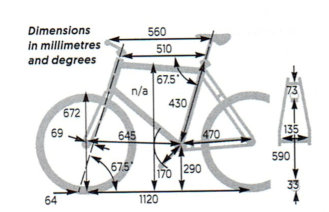 Q I’ve started to hear about Geometry in connection with bicycles.
Q I’ve started to hear about Geometry in connection with bicycles.
What has a school Maths subject got to do with riding a bike?
A It seems an odd connection,and in fact one of my own bikes is labelled “Trekking Geometry” which provides a clue.
Geometry at school is all about circles, squares, and triangles, but in the real world (and that includes bikes) it helps us to define things.
If you think about it, a bike is two circles, joined together by a double triangle (diamond) shaped frame. Add on steering, pedals etc.
When we sit on a bike we make another triangle from our seat to our head, and down to our hands, and this ‘virtual’ triangle is the most important. We need to be comfortable and at the same time , efficient. If we have to lean too far forward and squash our stomachs, bend our backs etc. then we won’t be comfortable, but if we are forced too far upright we become less efficient.
A lot depends on what we want to do on our bike. A short trip we can cope with a lot of poor position, but our needs for a long tour, whether it is all day, or several days ( back to my Trekking bike) are quite different to the needs of a sports or racing cyclist, and different again if you have an MTB or off road bike.
Our body ‘triangle’ is directly related to the contact points on the bike- the saddle, handlebars, and pedals. So the actual size and shape of the frame, and the size of the wheels makes a lot of difference.
The obvious essential is to have the right height so that it is both low enough for the rider to get on and off safey, whilst being high enough to the legs to get enough force into the pedals. Think about the sight of an adult riding a child sized bike !
Then the length has to be right for the type of riding you’ll do. Too long and you’ll be stretched out, too short and your knees will be nearly touching the handlebars.
Of course, from your geometry lessons at school you will realise that if you alter the length of one side of a triangle, the angle between the sides will change.
Other angles matter, too. The angle of the steering is important. Too upright and every bump in the road makes you wobble, too laid back and it’s harder to turn the handlebars.
That’s an overview of why Geometry is the word used to describe the vital shapes of a bike, but as the picture shows, it can get complicated.